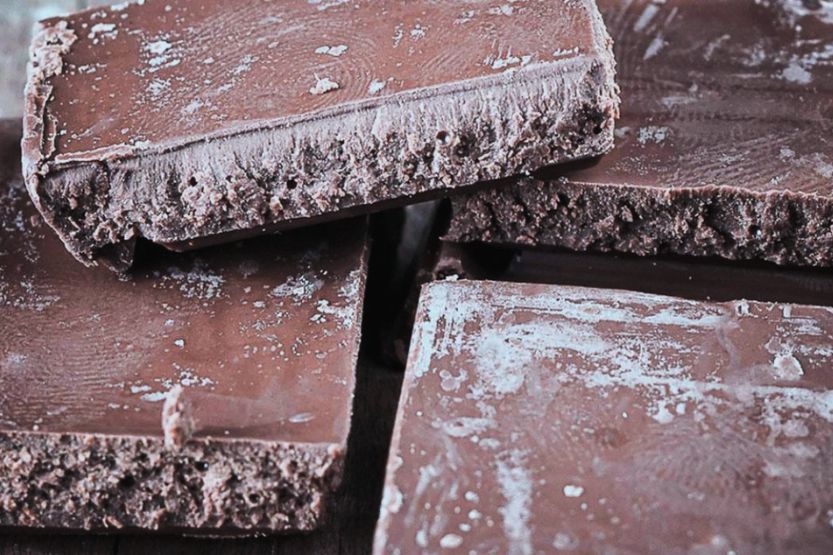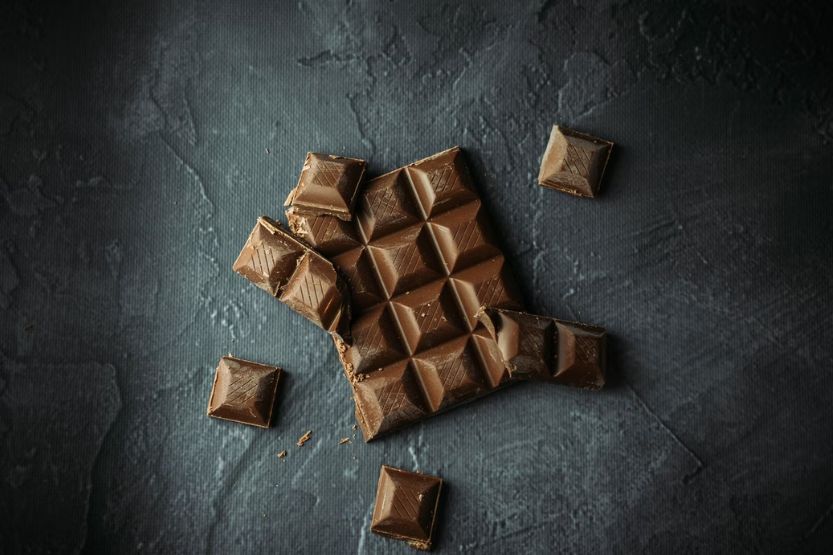So, you’ve got some chocolate sitting in your pantry for a while. Maybe you bought it for a party or just forgot it was there. When you go to eat it, you notice that there’s some white stuff on the top. What’s that white stuff on it? Is it mold? Is the chocolate ruined?
Nope! It’s not mold, and the chocolate is still good. That white substance is called bloom, which happens when cocoa butter or sugar crystallizes on top of the chocolate. There are two types of bloom:
- Fat bloom – This happens when too much fat has crystallized; and
- Sugar bloom (also known as white spot) is due to moisture that gets into the chocolate and breaks down the sugar crystals into smaller ones.
Both types are safe to eat but may not taste great. So if you’re worried about how your chocolate will taste, try melting it down into something new like brownies or hot cocoa.
Read on to know more about moldy chocolates, why chocolates turn white, and if they’re safe to consume.
Molds on Chocolate

It is extremely difficult for chocolate to grow mold since the chocolate bars we buy from stores lack enough moisture for mold formation. Mold and germs cannot thrive in chocolate because it is dry and moisture-free.
Although it may appear quite similar to mold, the white, chalky coating you notice on the chocolate is called bloom and is entirely unrelated to mold.
It only affects the outside of the chocolate because it happens when it’s exposed to different temperatures or outside moisture.
Chocolate Bloom
Bloom results from either the fat or sugar in the chocolate crystallizing, which gives the chocolate its off-white chalk coating or specks.
When chocolate is made by hand at home with wet ingredients, that is the one instance when people most frequently observe mold on it. This might occur with homemade truffles or other sweets made of chocolate with wetter consistency.
However, store-bought chocolate bars are typically dry and moisture-free, so this won’t happen with them.
Two Types of Chocolate Bloom
Fat bloom and sugar bloom are two common types of discoloration that can occur in chocolate. Both fat and sugar bloom are harmless and won’t affect the taste or texture of your chocolate:
1. Fat Bloom
Fat bloom or cocoa butter bloom happens when the chocolate has been stored at too high a temperature or for too long. It appears as a white, powdery coating on the surface of the chocolate. It is sticky when you touch it.
2. Sugar Bloom
Sugar bloom happens when moisture comes into contact with the chocolate. This can happen when it’s exposed to high humidity or just sitting in your pantry after being unwrapped from its package.
It appears as a whitish, crystalline layer that forms on top of the chocolate. You’ve probably seen it on candy bars before. Lastly, unlike the fat bloom, which is sticky, the sugar bloom is dry.
Is It Safe to Eat Chocolate with Bloom?
Have you thrown out chocolate because it had a white coating on the surface? You might be disappointed to learn that the chocolate was perfectly safe to consume and that you didn’t even need to throw it away!
Chocolate Bloom Won’t Make You Sick
While it is always better to play it safe and not eat food you are unsure of, if you see a white coating on chocolate, you can be sure it is fine.
It won’t make you sick or endanger you if you eat chocolate bloom. But you could note that the chocolate is slightly grainier than usual, changing only in texture.
Slightly Off Chocolate Flavor
The flavor of the chocolate might lessen, but again, this is okay. If you don’t want to eat chocolate that has bloom on it, you may always use it in recipes that ask for chocolate. After melting chocolate, the bloom vanishes, restoring its original appearance.
Can Chocolate Contain Mold?
While extremely unlikely, there is a risk that chocolate could develop mold. As previously mentioned, the white layer you sometimes see on chocolate is usually either fat bloom or sugar bloom. But under very rare circumstances, chocolate may develop mold.
Moldy Cocoa Beans
The primary component of chocolate, cocoa, is harvested and then processed to produce chocolate. However, if the cocoa beans used to produce the chocolate were moldy before processing, that could be one way for mold to form on the chocolate.
If this happened, your chocolate would probably taste weird, which you would start noticing immediately. If the chocolate were to sit, it might grow mold over time, though this is uncommon.
Poor Packaging
In other rare circumstances, mold may be brought on by poor packaging or pathogens that the chocolate was exposed to while packaging.
Chocolate Has Other Ingredients
Mold may also be present because of other ingredients added to the chocolate, such as fruit or nuts. It is safer to toss the chocolate away and purchase a new bar if you’re ever doubtful.
Green vs. White Mold on Chocolate

Most Common Types of Mold Around the House
The two most common types of mold that you may discover growing in your house and on food are white mold and green mold.
Not the Same Types of Mold
Although the way the color develops is comparable, this does not imply that green mold and white mold are necessarily the same types of mold.
Grow on Different Medium
The main difference between these two types of mold are as follows:
- Green mold prefers to grow on food.
- White mold prefers to grow on wood-based surfaces or plants.
Green Mold Is Common in Fruits and Foods Rich in Starch
The color of mold you are most likely to encounter on fruit and meals high in starch, like bread, is green. Fruit also offers an excellent setting for this mold since it requires moisture to develop and thrive.
Do Not Consume Chocolates with Green Molds
Green mold would be present if there were any mold on chocolate, whether from moldy cocoa beans or poor packaging.
For your safety, never consume chocolate that has green mold on it. Instead, throw it out.
Again, is mold on chocolates safe to eat? The white or chalky substance on chocolates is not a mold; instead, it is called bloom. Chocolates with bloom have a slightly different taste, but they are safe to eat.
Can I Scrape Mold Off of Chocolates and Eat It?
You probably have fat bloom or sugar bloom on the surface of your chocolate, which is safe to consume and doesn’t need to be removed.
Not a Good Idea to Eat Food with Mold
You might be tempted to scrape off any actual mold from the chocolate before eating the remaining pieces. However, I always recommend throwing away food that has begun to grow mold because it is never a good idea to try to eat something that has already gone bad.
Low Risk of Foodborne Illnesses After Scraping Mold Off
However, some people don’t mind scraping the mold off of chocolate and eating the rest of it. If the mold hasn’t gone too far and you can cut away all the mold, there should be a lower risk of foodborne illnesses.
Temper the Chocolate If the Bloom Bothers You
You can temper or heat and cool the chocolate. Then, set it in a mold. Do this if the white, chalky coating bothers you. By doing so, you’ll again have chocolate that looks normal after removing the white film. But be aware that repeatedly tempering chocolate can change how it tastes.
How to Tell If Your Chocolate Bar Has Gone Bad
It’s frustrating to bite into a chocolate bar only to discover that it is stale. Maybe it’s not as fresh as it should be, moldy and gross, or it’s just not as sweet as you remember it being at the store.
The good news is that there are ways to tell whether or not your chocolate has gone bad. If your chocolate bar is still safe to eat, you may tell by looking for a few signs:
1. Green Mold on the Outside of the Chocolate Bar
If you see green discoloration or spots, then this means that your chocolate has begun to spoil and should be thrown away immediately.
2. Weird Odor
When your chocolate has been placed next to some strong-smelling savory foods, it can be extremely off-putting because chocolate absorbs the odor of anything nearby.
If your chocolate starts to smell savory but shows no other signs of deterioration, it should still be safe to eat.
But if you discover that your chocolate has a weird odor and hasn’t been near any other strong-smelling foods, it might be past its best-by date. When this happens, throw the chocolate away.
3. Check for Taste or Flavor
You should be able to tell immediately whether the chocolate has gone bad by tasting alone. However, this shouldn’t be your go-to method for determining whether suspicious food has spoiled.
Although it is improbable and uncommon for chocolate to spoil, spoiled chocolate will have an unpleasant or rancid taste. Also, this can taste like an overbearing cocoa flavor or unfamiliar flavors.
4. Expiration Date
First, make it a habit to check the chocolate’s best-by date before consuming it. Most of the time, consuming chocolate after its best-by date is perfectly fine because it only slightly lowers the chocolate’s quality. But this should not be too obvious.
If the chocolate bar has an expiration date, check it, especially if it contains other components like fruit, almonds, or caramel. And if the chocolate is past its expiration date, search for any signs of spoilage.
Frequently Asked Questions – Mold on a Chocolate Bar

What Does Mold on Chocolate Look Like?
Mold hardly ever forms on chocolate. Bloom is the white layer you see on chocolate that has been stored for a long time, and it is caused by either the fat or sugar found in the chocolate. You do not have to throw away the chocolate because consuming it is perfectly okay.
What Is That White Mold on Chocolate?
The seemingly white fungus on chocolate makes chocolate lovers worldwide queasy. Researchers have known for a long time that this change, known as a fat bloom, is brought on by liquid fat, like cocoa butter, moving through the chocolate and crystallizing on the candy’s surface.
Is It Safe to Eat Chocolate with Bloom?
Bloom doesn’t affect how well or how long your chocolate will last. You can still cook and consume it, but it is unappealing.
What Happens If You Accidentally Eat Moldy Chocolate?
You won’t likely die from eating mold, and you’ll digest it like any other food. And as long as your immune system is relatively strong, the worst you’ll likely experience is mild nausea or vomiting from the taste or idea of what you just ate.
How Do I Know If Chocolate Is Bad?
If the chocolate has cracks or specks on its surface, it has likely dried out since it was once fresh chocolate and has become stale. Additionally, discard the chocolate right away if it has mold on it. It will almost certainly taste like chocolate if it looks like regular chocolate.
Can Chocolate Get Spoiled?
White chocolate and milk chocolate, which have higher milk content, will expire more quickly than chocolate with lower milk content, such as dark, semi-sweet, and bittersweet chocolate. If chocolate has been sealed or stored properly, it can be consumed months after it has expired.
Conclusion – Can Mold Grow on Chocolate?
Mold on chocolate is not the same as chocolate bloom, so it’s important to know the difference.
Mold is a fungus that grows on food and can harm your health. It looks like fuzzy patches or spots on the surface of your chocolate.
On the other hand, the bloom is a harmless white coating that forms when cocoa butter or sugar crystallizes out of the solution during storage or transportation. They look like tiny little dots or lines on the surface of your chocolate.
Mold is dangerous to eat, but the bloom is not. If you see mold on your chocolate, throw it away! But if you see bloom, don’t worry — it’s perfectly safe to eat! Once you know the difference, you’ll never have to throw away a perfectly good chocolate bar again.
Read next:





